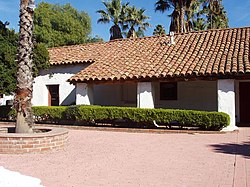| Pala | |
|---|---|
| Census-designated place | |
| San Antonio de Pala | |
 San Antonio de Pala Asistencia San Antonio de Pala Asistencia | |
 Location in San Diego County, California Location in San Diego County, California | |
  | |
| Coordinates: 33°21′55″N 117°4′36″W / 33.36528°N 117.07667°W / 33.36528; -117.07667 | |
| Country | United States |
| State | California |
| County | San Diego |
| Population | |
| • Total | 1,490 |
| Time zone | UTC-8 (Pacific (PST)) |
| • Summer (DST) | UTC-7 (PDT) |
| ZIP codes | 92059 |
| Area codes | 442/760 |
Pala is a small, mostly Native American community and census-designated place located within the Pala Indian Reservation in San Diego County, California. For centuries a traditional gathering place of native peoples. The Mission San Antonio de Pala or Pala Mission was established in Pala by early 19th century as an asistencia or sub-mission.
The community is north of Escondido in the San Diego-Carlsbad metro area. In the National Geographic Names database, it is officially catalogued as feature number 1661174. The community is in ZIP Code 92059, and inside area code 760.
The communities name may be derived from the Native American Cupeño or Luiseño language term pale, meaning "water." Another possible origin of the name is the Spanish word pala, which means "shovel."
The community is in the Pacific time zone. Pala is at an altitude of 404 feet, located at 33°21′55″N 117°04′36″W / 33.36528°N 117.07667°W / 33.36528; -117.07667 (latitude 33.365N, longitude 117.075W).
Mineral resources
After United States annexation of California following its victory in the Mexican–American War, Pala became known for its mineral resources, including gold and tourmaline. Numerous gem mines were established in 1890s, of which more than twenty are listed in the Mindat database. Gem mines in the Pala District still produce tourmaline, with the pink variety as the regional specialty.
China’s Empress Dowager Cixi (1860-1908) was said to have valued the pink tourmaline of Pala to be used for carving buttons and other fashion accessories which fueled a boom for pink tourmaline lasting from about 1901–1911. Local Pala area miner and gem cutter Fred Rynerson noted the best years for San Diego Tourmaline Mining Company were from 1903–1910, and the China trade customers were only interested in pink tourmaline cabochon material suitable for shaping vice gem quality for faceting.
The first discovery of Morganite has been attributed to both Pala and as Madagascar. Morganite also termed rose beryl was named by Dr. George F. Kunz at a meeting in December 1910 at the New York Academy of Sciences and put on display at American Museum of Natural History. Dr. Kunz appeared to be in possession of samples from both Madagascar and California at time of naming with the sample displayed coming from Madagascar. In contemporary accounts Dr. Kunz states Morganite was “principally found off Madagascar” implying that in 1910 it was known to exist in more than one place.
In 1902 the purple-colored gemstone kunzite discovered near Pala by Dr. George F. Kunz and by 1903 was named in his honor while being displayed at Tiffany and Co. and American Museum of Natural History, New York. Dr. Kunz’s 1932 obituary describes him as “Americas greatest expert on gems”
The 1915 San Diego Panama–California Exposition featured a reproduction of the Pala Chief Mine termed “The Gem Mine”. In order to match the original mine, there were timbers and red pay streak mud brought from Pala Mountain to San Diego’s Balboa Park where it was used in a display of tunnels with replicated gem pockets of tourmaline, beryl, and kunzite as found at the Pala Chief mine.
Attractions
- Mission San Antonio De Pala
- Pala Casino Spa and Resort
- Fox Raceway
- Wilderness Gardens County Preserve
- Pala Shooting Range
- Oceanview Mine
See also
References
- "US Census Bureau". www.census.gov. Retrieved September 11, 2024.
- Lovejoy, Ora A. (1918). "A Study of Southern California Place Names". Annual Publication of the Historical Society of Southern California. 11 (1): 45. doi:10.2307/41168758. JSTOR 41168758.
- Pala District, at Mindat.org
- Ferderman, David (September 1991). "California Gem Mining: Chronicle of a Comeback". Modern Jewler.
- Rynerson, Fred (1967). Exploring and Mining Gems & Gold in the West. Happy Camp, Ca. Naturegraph. pp. 12–13. ISBN 978-0-911010-60-2.
- Rynerson, Fred (1967). Exploring and Mining Gems & Gold in the West. Happy Camp, Ca. Naturegraph. pp. 43–44. ISBN 978-0-911010-60-2.
- "Science". Scientific Notes and News. 33 (838): 105. January 20, 1911. JSTOR 1637660.
- "Morgan Gives Morganite". American Art News. January 14, 1911. p. 1. JSTOR 25590672.
- "New Gem Name". Argus-Leader. December 6, 1910. p. 6.
- Baskerville, Charles (August 12, 1903). "Kunzite, a New Gem". Science. 18 (453): 303–304. doi:10.1126/science.18.453.303.b. JSTOR 1631771.
- "Dr. George F. Kunz, Expert on Gems, Dies". The Boston Globe. June 30, 1932. p. 36.
- "Pala Chief Mine". mindat.org. Retrieved December 2, 2024.
- "Panama–California Exposition The Gem Mine". San Diego Panama–California Exposition 1915 Official Views: 24. 1915.
- Pittsburghia, Miss (December 27, 1914). "Gem Mine to be Reproduced for San Diego Exposition". Pittsburgh Post-Gazette. p. 13.
This San Diego County, California–related article is a stub. You can help Misplaced Pages by expanding it. |
